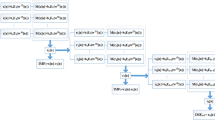Abstract
In this paper, the application of the Prony’s method based on Empirical Mode Decomposition (EMD) and Ensembled Empirical Mode Decomposition (EEMD) for identification of dominant modal parameter, oscillation frequency, is presented. The validation of the methods are done on real frequency signal obtained from FNET/GridEye, GPS-synchronized wide-area frequency measurement network obtained during tornado outbreak in Southeastern U.S. According to many studies and reports, the values of dominant modal parameters from such event, are already known, and have been used to compare method performance and accuracy of results. Firstly, EMD and EEMD are performed over the frequency time series to obtain intrinsic mode functions IMFs, on which the Prony’s method for frequency oscillation extraction is further applied. In addition, according to obtained results the proposed methods have proven to be reliable for identification of the model parameters of low-frequency oscillation in power systems.
Access this chapter
Tax calculation will be finalised at checkout
Purchases are for personal use only
Similar content being viewed by others
References
EPRI: Interconnected Power System Dynamics Tutorial, EPRI, Final Report Third Edition TR-107726-R1, January 1998
Terzija, V.: Wide area monitoring protection and control—WAMPC. In: IET-UK International Conference on Information and Communication Technology in Electrical Sciences (ICTES 2007), Tamil Nadu, pp. 1–7 (2007)
Zhang, Y.: Frequency Monitoring Network (FNET) Data Center Development and Data Analysis. Ph.D. dissertation, University of Tennessee (2014)
Rosso, A.: Demonstration of a novel synchrophasor-based situational awareness system: wide area power system visualization. On-line Event Replay and Early Warning of Grid Problems (2012)
Kakimoto, N., Sugumi, M., Makino, T., Tomiyama, K.: Monitoring of inter area oscillation mode by synchronized phasor measurement. IEEE Trans. Power Syst. 21(1), 260–268 (2006)
Hauer, J., Demeure, C., Scharf, L.: Initial results in Prony analysis of power system response signals. IEEE Trans. Power Syst. 5(1), 80–89 (1990)
Shim, K., Nam, H., Lim, Y.: Use of Prony analysis to extract sync information of low frequency oscillation from measured data. Eur. Trans. Electr. Power 21(5), 1746–1762 (2011)
Guoping, L., Quintero, J., Venkatasubramanian, V.: Oscillation monitoring system based on wide area synchrophasors in power systems. In: Bulk Power System Dynamics and Control—VII. Revitalizing Operational Reliability, iRE Symposium, pp. 1–13 (2007)
Laila, D.S., Messina, A.R., Pal, B.C.: A refined Hilbert-Huang transform with applications to inter area oscillation monitoring. IEEE Trans. Power Syst. 24(2), 611–620 (2009)
Echeverria, J., Crowe, J., Woolfson, M., Hayes-Gill, B.: Application of empirical mode decomposition to heart rate variability analysis. Med. Biol. Eng. Comput. 39(4), 471–479 (2001)
Battista, B.M., Knapp, C., McGee, T., Goebel, V.: Application of the empirical mode decomposition and Hilbert-Huang transform to seismic reflection data. Geophysics 72(2), H29–H37 (2007)
Zhengyou, H., Shibin, G., Xiaoqin, C., Jun, Z., Zhiqian, B., Qingquan, Q.: Study of a new method for power system transients classification based on wavelet entropy and neural network. Int. J. Electr. Power Energy Syst. 33(3), 402–410 (2011)
Oleskovicz, M., Coury, D.V., Felho, O.D., Usida, W.F., Carneiro, A.A., Pires, L.R.: Power quality analysis applying a hybrid methodology with wavelet transforms and neural networks. Int. J. Electr. Power. Energy Syst. 31(5), 206–212 (2009)
Avdakovic, S., Nuhanovic, A., Kusljugic, M., Music, M.: Wavelet transform applications in power system dynamics. Electr. Power Syst. Res. 83(1), 237–245 (2012)
Bruno, S., De Benedictis, M., La Scala, M.: “Taking the pulse” of power systems: monitoring oscillations by wavelet analysis and wide area measurement system. In: Power Systems Conference and Exposition, 2006. PSCE ’06.2006 IEEE PES, pp. 436–443 (2006)
Kundur, P.: Power system stability and control. Information on the state of air quality in the Sarajevo Canton for 2018. McGraw Hill, Ministry of Physical Planning, Construction and Environmental Protection 1994. mpz@mpz.ks.gov.ba
Huang, H.E., Shen, Z., Long, S.R., Wu, M.C., Shih, H.H., Zheng, Q., Yen, N.C., Tung, C.C., Liu, H.H.: The empirical mode decomposition and the Hilbert spectrum for nonlinear and non-stationary time series analysis. Proc. R. Soc. Lond. A 454, 903–995 (1998)
Dedovic, M.M., Avdakovic, S., Dautbasic, N.: Impact of air temperature on active and reactive power consumption—Sarajevo case study. Bosanskohercegovačka elektrotehnika
Hao, Q.: Application of Prony algorithm based on EEMD for identifying PSS parameters. IOP Conf. Ser. Earth Environ. Sci. 440, 032129 (2020). https://doi.org/10.1088/1755-1315/440/3/032129
Wu, Z., Huang, N.E.: Ensemble empirical mode decomposition: a noise-assisted data analysis method. Adv. Adapt. Data Anal. 1, 1–41 (2009)
Chao, B.F., Gilbert, F.: Autoregressive estimation of complex eigenfrequencies in low frequency seismic spectra. Geophys. J. R. Astr. Soc. 63, 641–657 (1980)
Arpanahi, M.K., Kordi, M., Torkzadeh, R., Alhelou, H.H., Siano, P.: An augmented Prony method for power system oscillation analysis using synchrophasor data. Energies 12, 1267 (2019). https://doi.org/10.3390/en12071267
Tasnim, K.N., Hasan, M.T., Reza, M.S.: Empirical mode decomposition based Prony’s method for fundamental and harmonics analysis of power system. In: 2019 International Conference on Electrical, Computer and Communication Engineering (ECCE), Cox’s Bazar, Bangladesh, 2019, pp. 1–6. https://doi.org/10.1109/ECACE.2019.8679300
Author information
Authors and Affiliations
Corresponding author
Editor information
Editors and Affiliations
Rights and permissions
Copyright information
© 2021 The Editor(s) (if applicable) and The Author(s), under exclusive license to Springer Nature Switzerland AG
About this chapter
Cite this chapter
Dedovic, M.M., Mujezinović, A., Dautbasic, N. (2021). Identification on Dominant Oscillation Based on EMD and Prony’s Method Approach. In: Avdaković, S., Volić, I., Mujčić, A., Uzunović, T., Mujezinović, A. (eds) Advanced Technologies, Systems, and Applications V. IAT 2020. Lecture Notes in Networks and Systems, vol 142. Springer, Cham. https://doi.org/10.1007/978-3-030-54765-3_8
Download citation
DOI: https://doi.org/10.1007/978-3-030-54765-3_8
Published:
Publisher Name: Springer, Cham
Print ISBN: 978-3-030-54764-6
Online ISBN: 978-3-030-54765-3
eBook Packages: Intelligent Technologies and RoboticsIntelligent Technologies and Robotics (R0)




